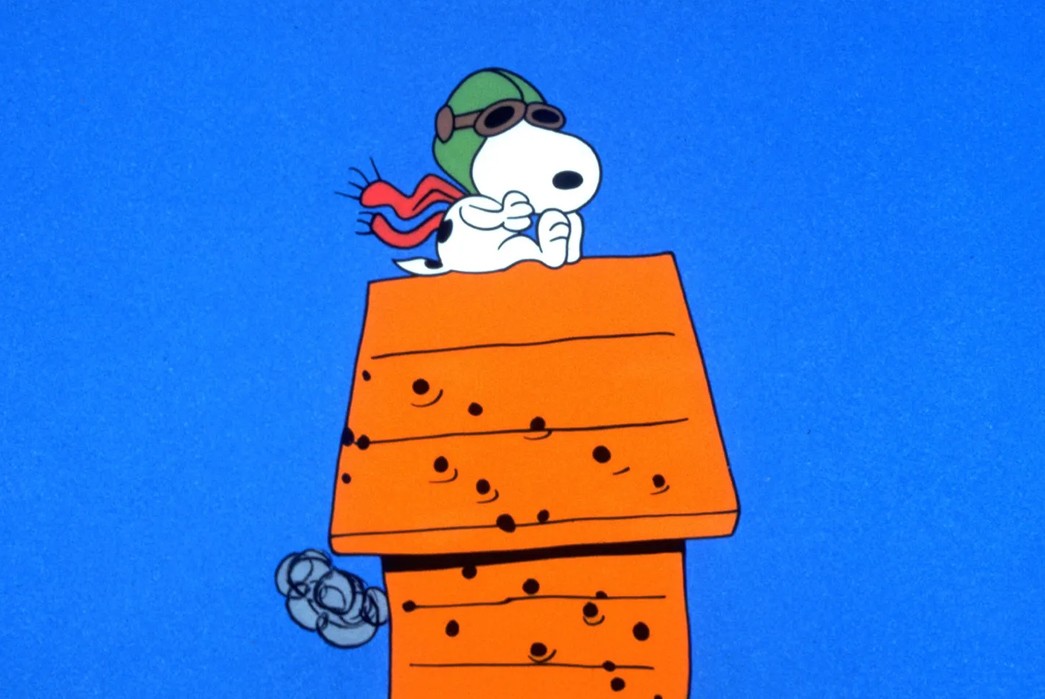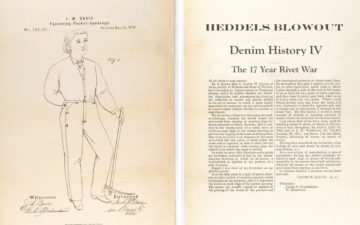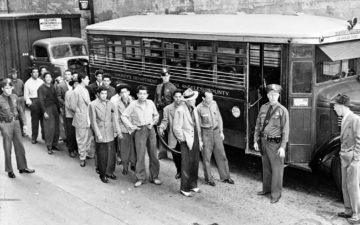There are a lot of answers you’ll get to the question “What’s the longest story ever told?” The Bible. Marcel Proust’s A la recherche du temps. But the real answer is a simple four-panel comic written by one man, Charles M. Schulz, between the years 1950 and 2000. It’s a story about a group of misfit children and a beagle with an active imagination: Peanuts.
Heddels is all about things that last and Peanuts has been going strong for over 70 years, has outlived its creator, and isn’t going to see an end anytime soon. Schulz’s extensive merchandising, the comic’s countercultural influence and its characters becoming part of the visual lexicon of the Vietnam War—all of which we will explore later—also mean that Peanuts has played a huge role in vintage clothing and heritage reproductions from its start in 1950 until now.
In this two-part series, we’ll be investigating the effect that Peanuts has had on both mainstream culture and counterculture over the past 73 years. To kick things off, we’re going to take it back to the very start and explore what the cartoon is all about and determine why it’s so popular after all this time.
Sparky and Spike
Charles M. Schulz was born on November 26 1922 in Minneapolis, Minnesota. Comics became a part of his life very early on after his uncle nicknamed him Sparky after the horse Spark Plug from Billy Debeck’s Barney Google. All Schulz wanted to do as a kid was “draw funny pictures” so he picked up the pencils early on, often drawing their family dog, Spike. Spike, unlike his future namesake, did not live in the Mojave Desert but did eat pins, tacks, screws, and razor blades. We learned this from Schulz’s first-ever published cartoon: a drawing of Spike from a national Ripley’s Believe It or Not newspaper feature from 1937. Schulz was just 15 years old. A few years later, as a Senior in high school, Schulz enrolled in a correspondence cartoon course at the Federal School of Applied Cartooning.
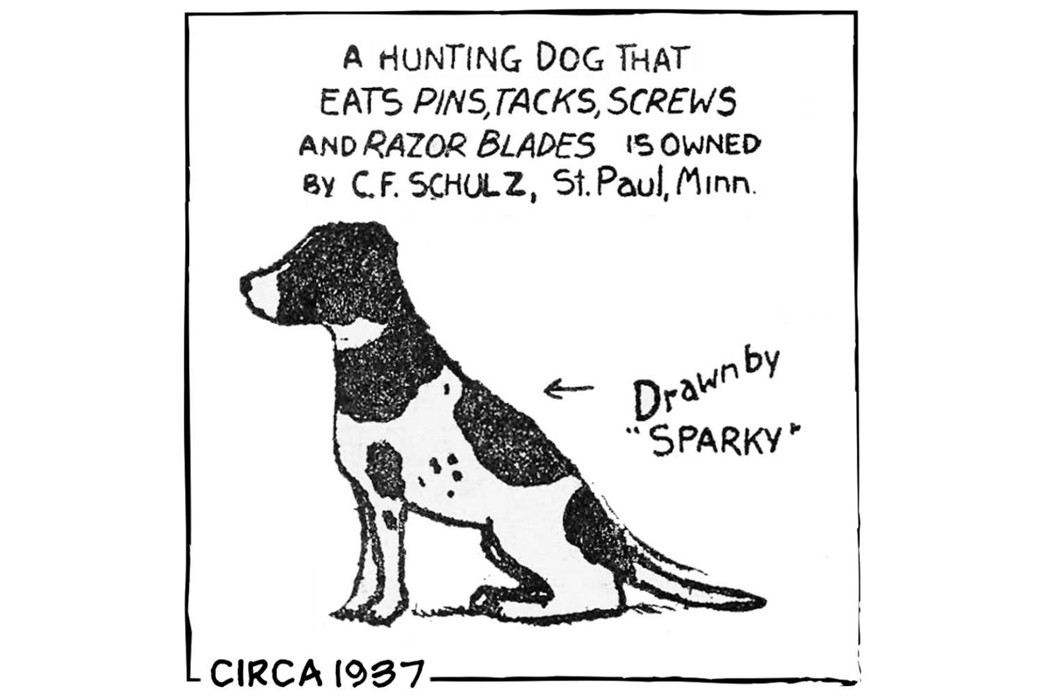
Spike by Sparky via Ripley’s
Like everything else, the early ‘40s took a knock on Schulz’s career as a cartoonist. In 1943, he lost his mother to cancer and, shortly after, he was drafted. Schulz spent the following two years training at Camp Campbell in Kentucky before being posted in Europe. The future cartoonist was then a squad leader of the 50 caliber machine gun team in the 20th Armored Division of the US Army. Though, Schulz never actually saw combat. He never fired his weapon and the one German he came face-to-face with quickly surrendered. Nevertheless, the events of the previous two years, the death of his mother and being drafted into the army, had a profound effect on the young Schulz.
Returning from the war in 1945, Schulz again swapped his machine gun for his signature pens; an Esterbrook 914 Radio pen for drawing and a Speedball C-5 for lettering. With a day job at his alma mater, he sold occasional one-panel cartoons to The Saturday Evening Post and, in 1947, got his first regular gig. Li’l Folks was published in the women’s section of his local paper the St. Paul Pioneer Press. The comic strip featured that familiar Schulz look of little kids with big heads and introduced a kid called Charlie Brown and his black and white dog, Rover, on 30 May 1948. Two years in, Schulz quit the Pioneer Press. The paper refused to move Li’l Folks to their comics section and wouldn’t pay more for Schulz’s talent. They also never returned any of his original, hand-drawn artworks leading to Schulz clipping them from the paper himself for his scrapbook—which ended up as a collection of around 7000 artworks.
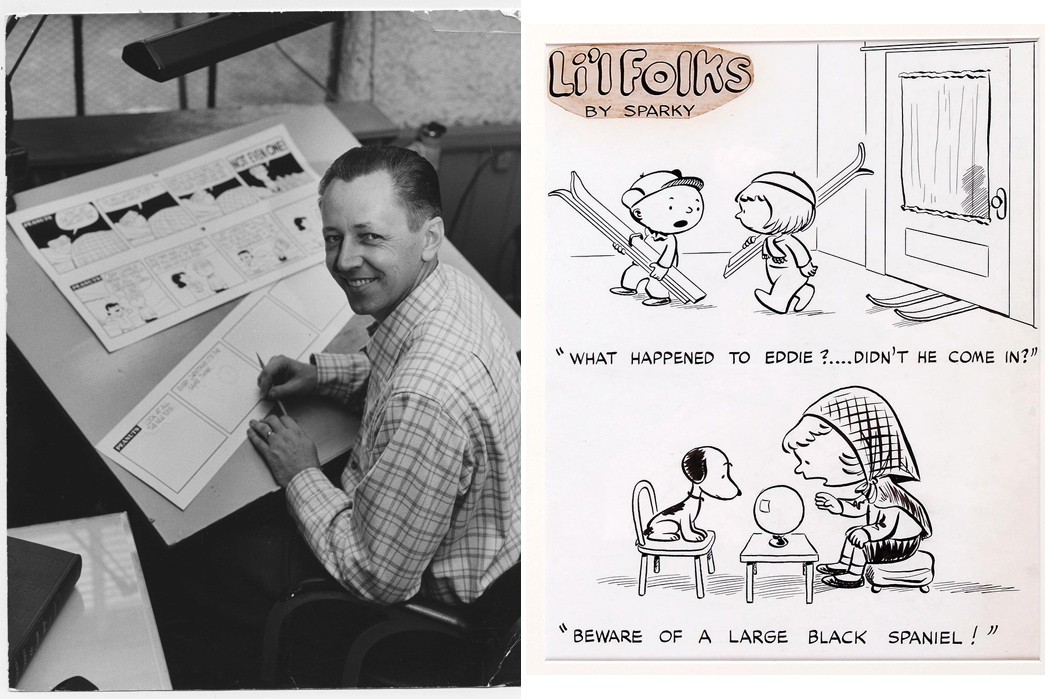
Charles M Schulz at his writing desk in 1956 via Jordan Schnitzer Museum of Art and Rover the Dog in Li’l Folks via Comic Art Fans
Knowing his worth, Schulz approached the United Feature Syndicate with Li’l Folks, which he had now redeveloped into a four-panel comic strip with a cast of characters. UFS was immediately interested. They quickly accepted Li’l Folks but with one hesitation; cartoonist Tack Knight wasn’t happy that the name was so close to his 1930s comic Little Folks. UFS’s production manager suggested Peanuts, after the peanut gallery on the super popular children’s TV show Howdy Doody. Schulz hated the title—and continued to for the rest of his life—but, regardless, the first edition of his new comic strip Peanuts was published on October 2 1950 in seven newspapers across the US.
Good Ol’ Charlie Brown
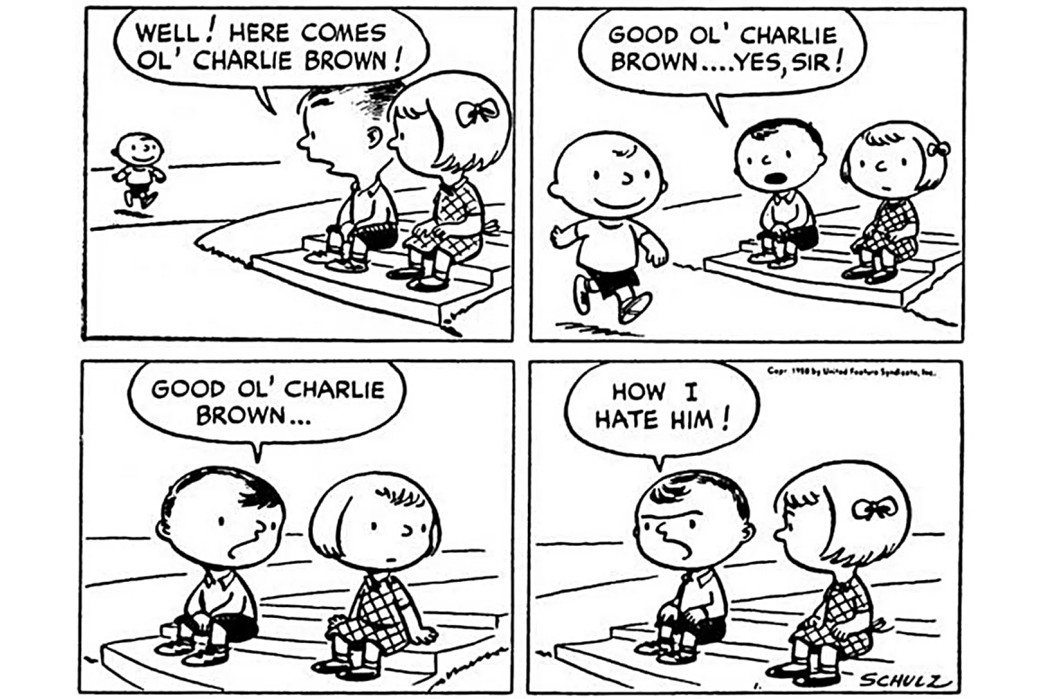
The first Peanuts strip from October 2 1950 via Spokesman.
The first Peanuts strip established two things: the comic’s main and only consistent character, Charlie Brown, and the cruel world that he calls home. The four panels showed Charlie Brown going about minding his own business, whilst two other children watch him—first calling him “Good Ol’ Charlie Brown”, before saying “how I hate him” once Charlie has left. This is just the start of a 50-year continuous streak of bad luck for good ol’ Charlie Brown. He never wins at baseball, he never gets the Little Red-Headed Girl, and he never kicks the football (though that’s not entirely on him). Peanuts’ main character is depicted as constantly suffering, nervous, and lacking in self-confidence. Do we feel sorry for Charlie Brown—or do we see ourselves as him?
Despite his downtrodden look on life, Schulz also showed Charlie Brown as ever-persevering, caring deeply about his friends, and a resilient, courageous, and ambitious young boy. There are suggestions that the character was a reflection of what Schulz saw as the real American dream: no matter how many times you get knocked down, you always have to get up again. There is a reason why Charlie Brown was voted as TV Guide’s 8th best cartoon character of all time.
For the first few years of Peanuts, Schulz focused on Charlie Brown and his beloved beagle, Snoopy. But then, over the next 20 years, he started to introduce more and more friends and associates of Charlie Brown. This group of eccentric children became what we now refer to as The Gang.
The Gang
The Peanuts Gang is made up of 9 children, who appeared at various different frequencies over the 50 years Schulz told the story for, a beagle and a small yellow bird. Schulz weaved many people and elements from his real life into his characters.
Schroeder

BEETHOVEN! via Peanuts
Named after one of Schulz’s childhood friends, Schroeder’s first appearance in the comics was on May 30, 1951. Schroeder is a moody musician and Beethoven lover—he celebrates the composer’s birthday every year, believing it should be a national holiday. Schulz gave him a small piano to play his sonatas on as he had given a very similar piano to his daughter, Meredith.
Lucy

Lucy Van Pelt via Cambridge Edition.
Lucy Van Pelt was seen as the bossy, crabby member of The Gang from her debut on March 3, 1952. But is she? She’s a strong woman, opinionated, and always standing up for herself and speaking out for women’s rights—rightfully making her a second-wave feminist icon. Lucy’s 5-cent psychiatric help stand is one of Peanuts‘ most iconic and cherished images.
Linus
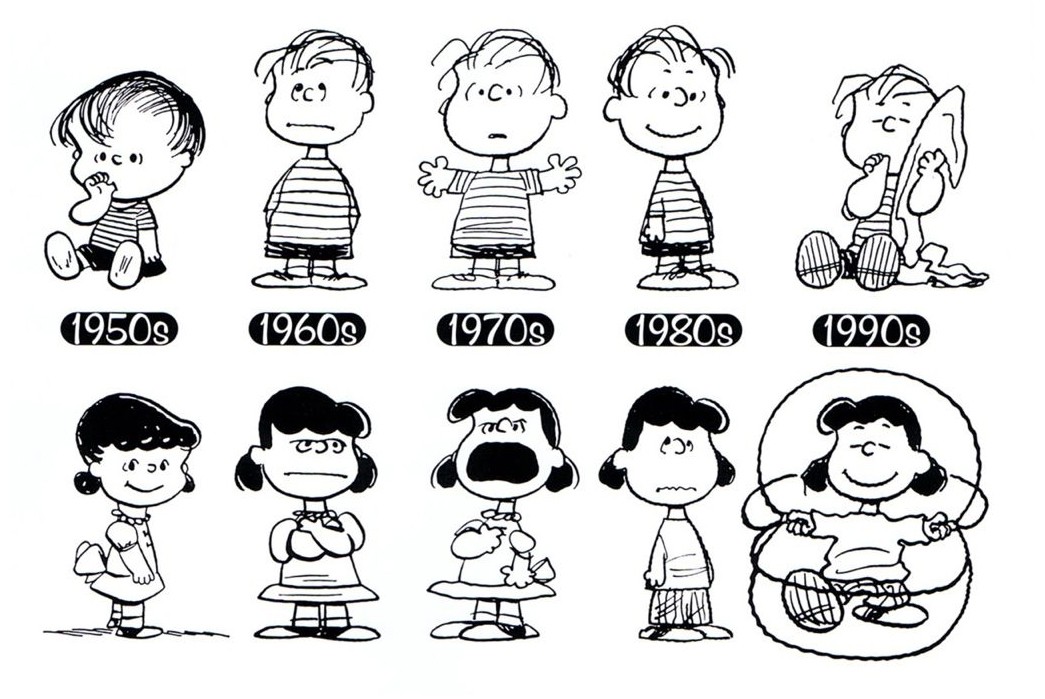
Linus and Lucy, the Van Pelt siblings, through the years via Pinterest
First drawn by Schulz on September 19, 1952, Linus is both Lucy’s little brother and Charlie Brown’s closest friend and confidant. Linus is philosophical and a deep thinker, and often acts as the voice of reason when things get heated. He also famously carries a security blanket—which introduced this concept to the world.
Pigpen
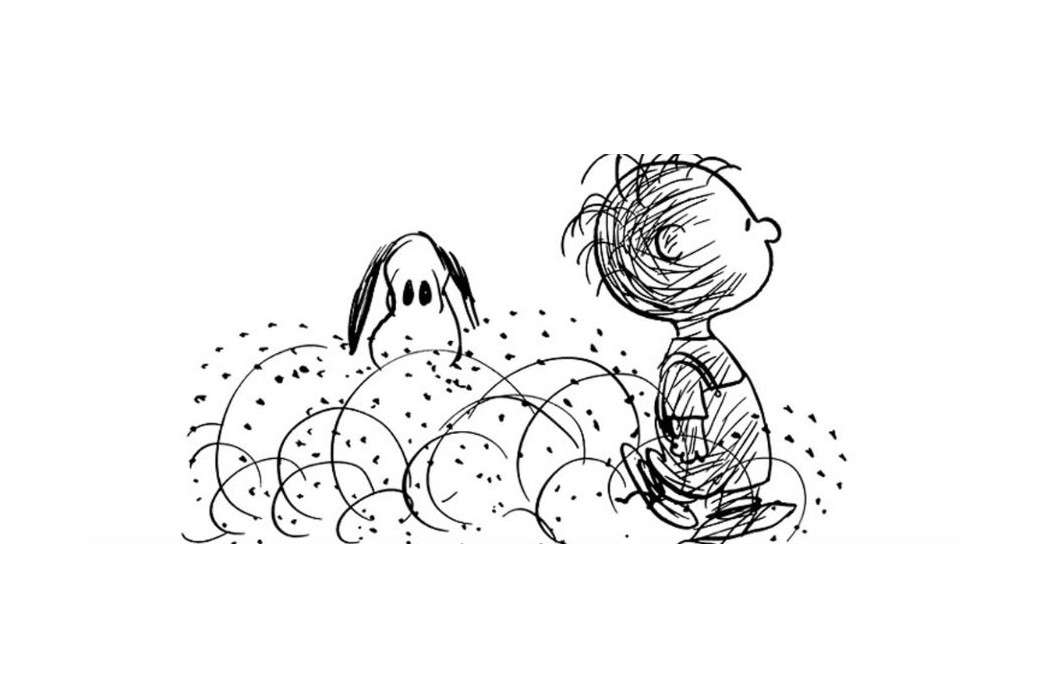
Pigpen (right) via Stomy Warren.
One of the most popular characters, Pigpen only had just over 100 appearances in Peanuts‘ original 50-year run. From his initial appearance on July 13, 1954, Pigpen has traveled around in his own dust cloud. Though, he sees his dirt as a point of pride—calling it “the dust of countless ages”. Despite his appearance, Pigpen always treats the other members of The Gang with dignity and respect.
Sally
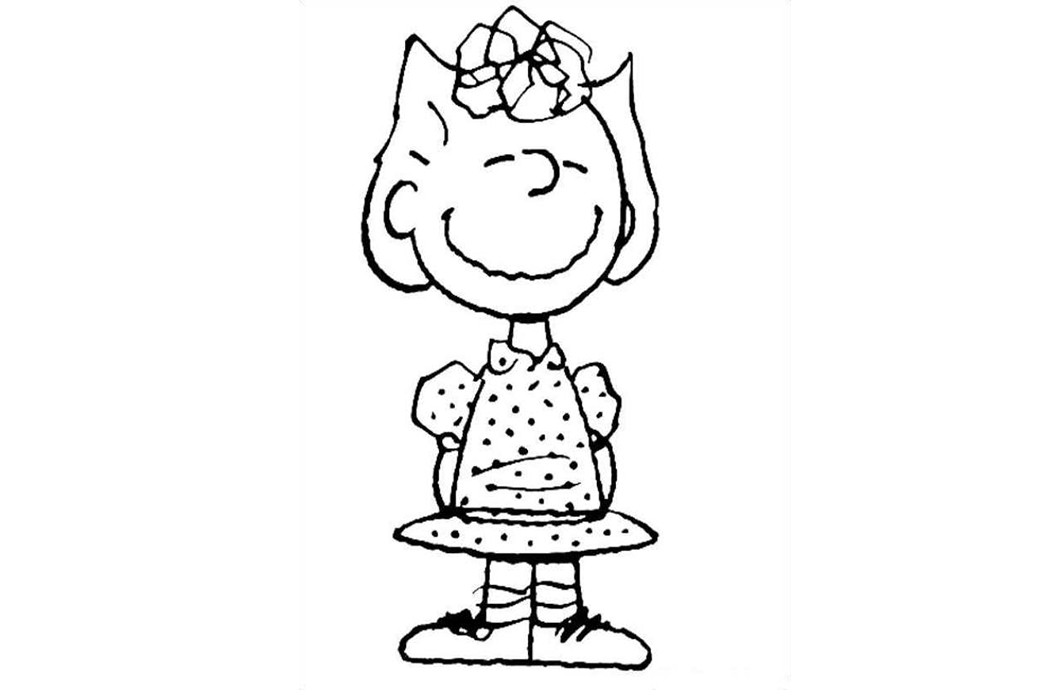
Sally via Kids ‘n’ Fun
9 years after the strip premiered, Schulz gave Charlie Brown a younger sister, Sally, who debuted on August 23, 1959. Sally is ever-curious and demands answers for everything, which often puts her in contempt of her personal philosophies: “Who cares?”, “life goes on”, and “How should I know?”. She and her elder brother never seem to understand each other, but she always turns to him for help and encouragement.
Peppermint Patty
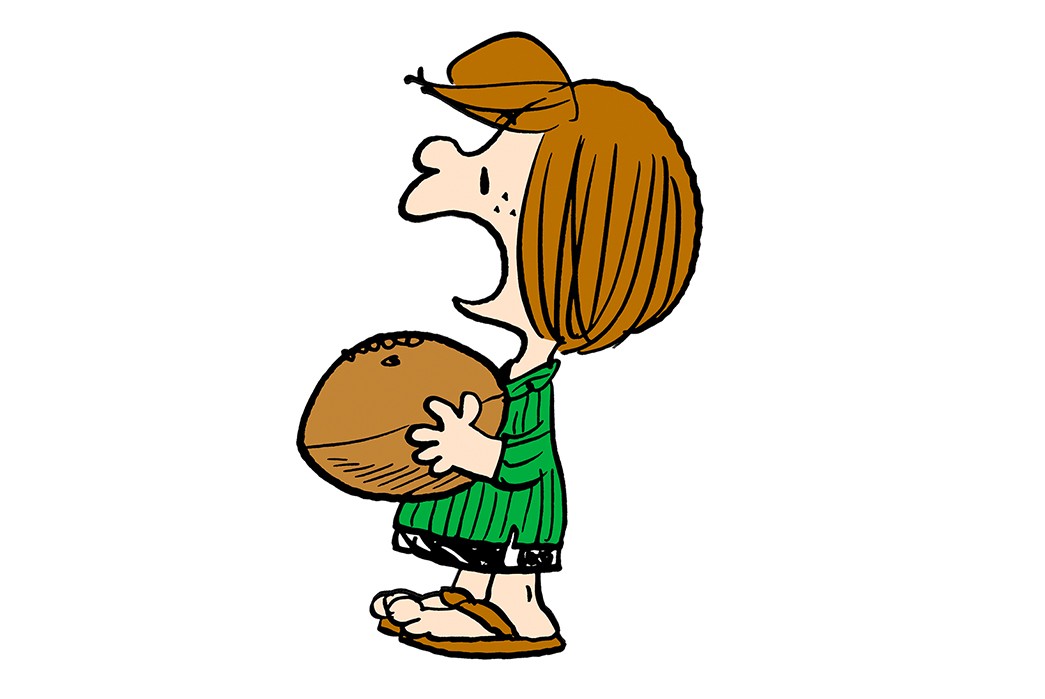
Peppermint Patty via Peanuts.
Peppermint Patty, or to give her her full name Patricia Reichardt (after Schulz’s secretary), first joined The Gang on August 22, 1966. Patty is sporty and the manager of The Gang’s baseball team. However, she is also a thinker—often found sitting against her “thinking tree” contemplating life and love.
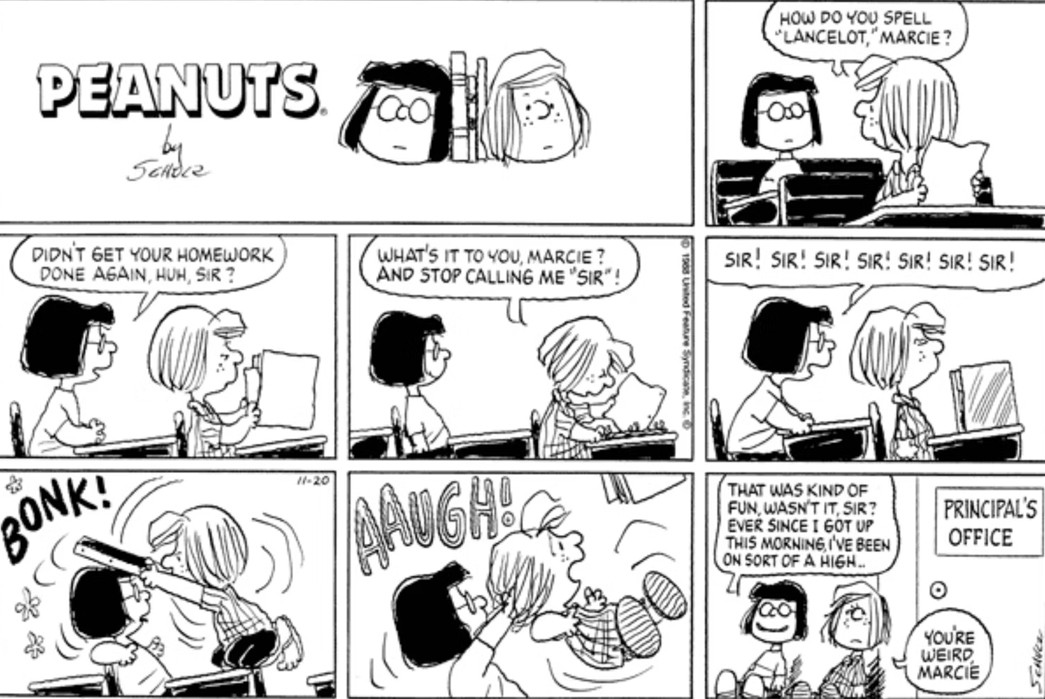
Stop Calling Me “Sir”!, November 20 1988 via Screen Rant
Marcie
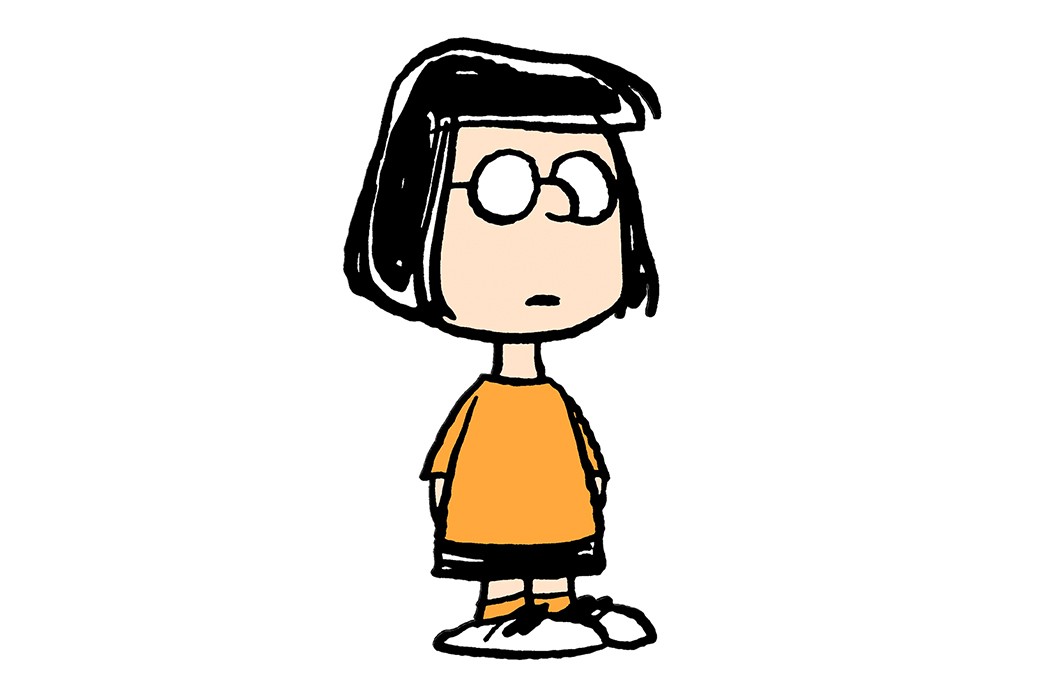
Marcie via Peanuts.
First introduced as Peppermint Patty’s best friend on July 20, 1971, Marcie and Patty first met at summer camp and she’s called Patty “sir” ever since. Marcie isn’t as sporty as the rest of that gang but still supports her friends. She is a lover of school and taking hikes in nature.
Franklin
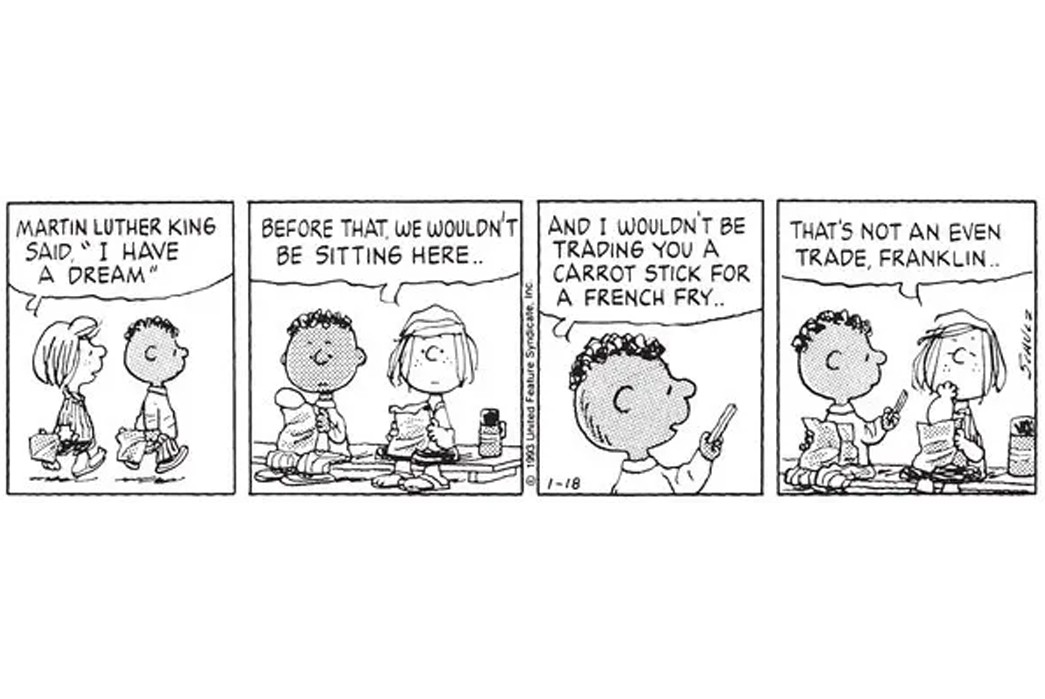
MLK, carrot sticks, and french fries via The New York Times
Franklin first appeared in the comics on July 31, 1968. Peanuts‘ first black character, was introduced after Los Angeles-based teacher Harriet Glickman wrote to Schulz suggesting that a black character in a strip like Peanuts could help to sway American attitudes towards race. With his father fighting in Vietnam, Franklin meets Charlie Brown on a trip to the beach with his grandparents. He later visits Charlie Brown and finds the rest of The Gang to be a little odd.
Woodstock
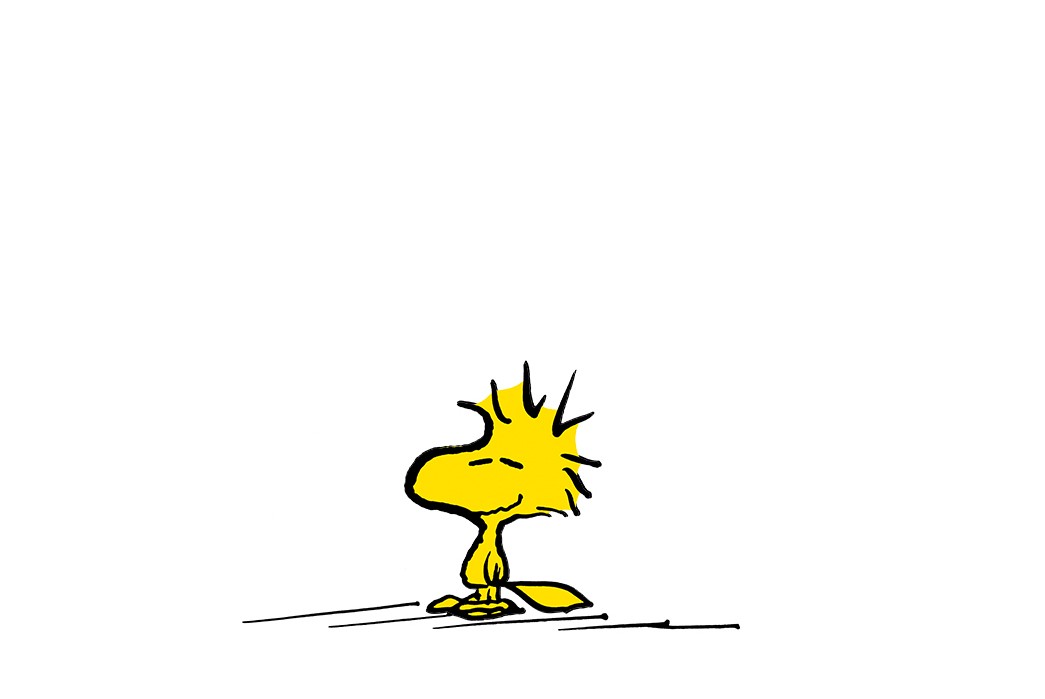
Woodstock via Peanuts.
A small yellow bird was first featured in Peanuts on April 4, 1967, but it wasn’t until three years later that he was named after the groundbreaking 1969 festival. Woodstock doesn’t know what type of bird he is and is not a great flyer. He is a “friend of friends’ with Charlie Brown’s pet beagle.
The World’s Most Famous Beagle
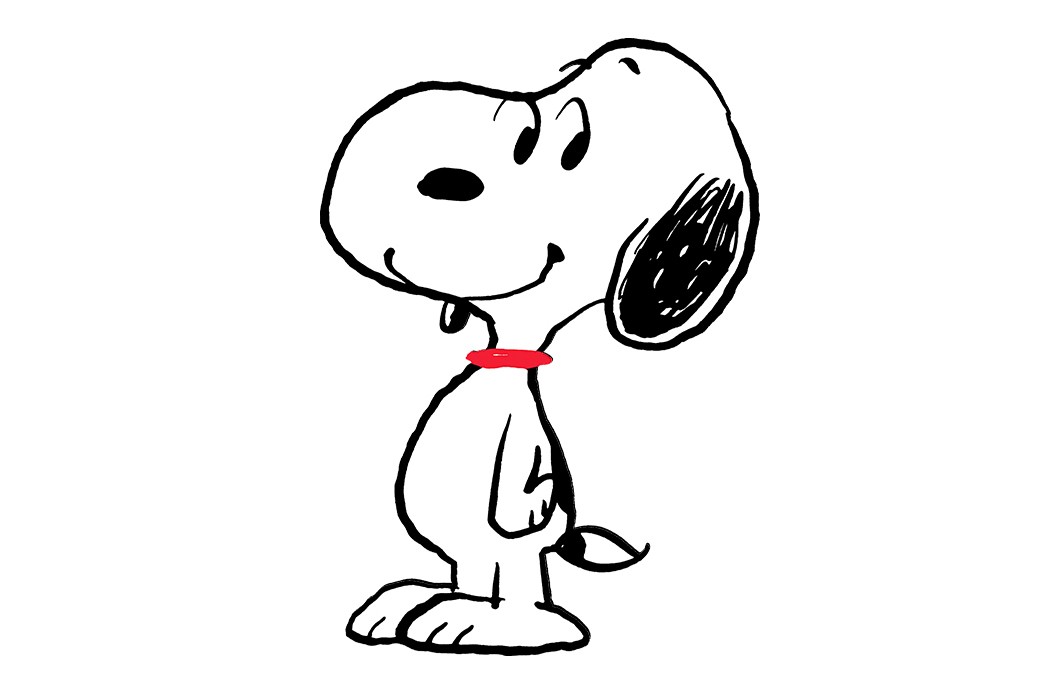
Snoopy via Peanuts.
On October 4, 1950, Schulz introduced Charlie Brown’s pet dog. Roughly based on Schulz’s boyhood pet Spike, in the early days, he was an unnamed beagle that walked on all fours and acted, well, like a dog. On November 10 that year he was given the name Snoopy—which has now become a household name across the world.
Though he started like a normal dog, over the years of Peanuts, Snoopy became more and more anthropomorphic and started thinking like a human. From 1952 onwards, Peanuts readers were able to read his thoughts in thought bubbles. Snoopy was his creator’s way of taking his comic out of the scope and confines of the lives of small children. Snoopy showed the true power of imagination: he’s a writer, trying to write the world’s greatest novel, an astronaut, a Flying Ace, an attorney, a Scout leader, ice skater, and so much more. He allowed Schulz to explore the brighter side of life.
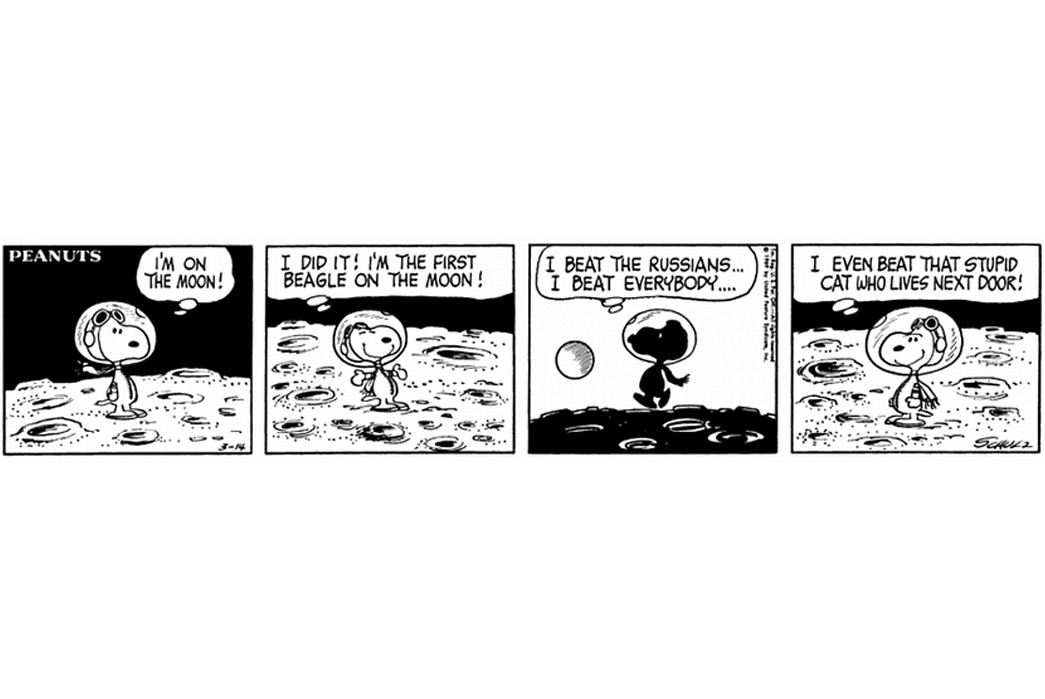
The First Beagle on the Moon, March 4 1969 via Blake Scott Ball
Snoopy’s home, a red doghouse, was originally shown from the front so the audience could see inside. Schulz soon turned the house to the side, so we no longer knew what was happening in there. This turned the doghouse into an essential part of Snoopy’s fantasy world, where he somehow managed to store a plane, a typewriter, and endless costumes.
Snoopy isn’t without his detractors. Some claim that his flight of fancy is selfish and distracts from the more serious undertones of Peanuts. But, Snoopy also showed readers of all ages that they should dare to dream—they were only limited by their own imaginations. In the world of Charlie Brown and The Gang, where it seems that nobody ever gets what they want, this daydreaming beagle is a welcome breath of fresh air. And sometimes, like us all, he just wanted a nap and his dinner.
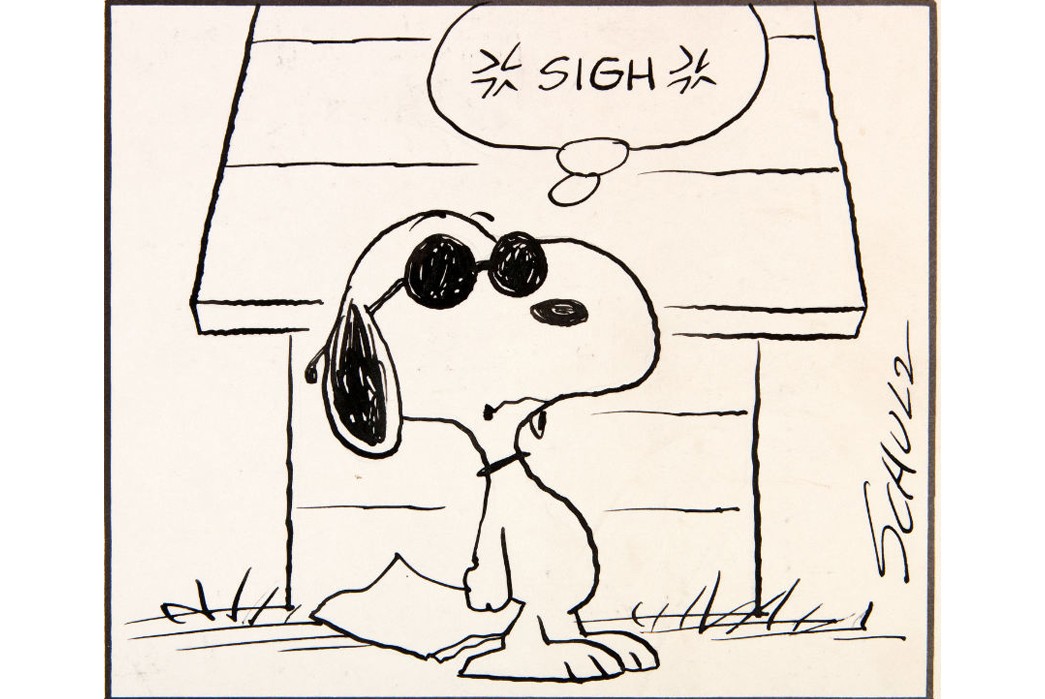
The first introduction of Joe Cool, one of Snoopy’s alter-egos, May 27, 1971, via Hake’s
The Longest Story Ever Told
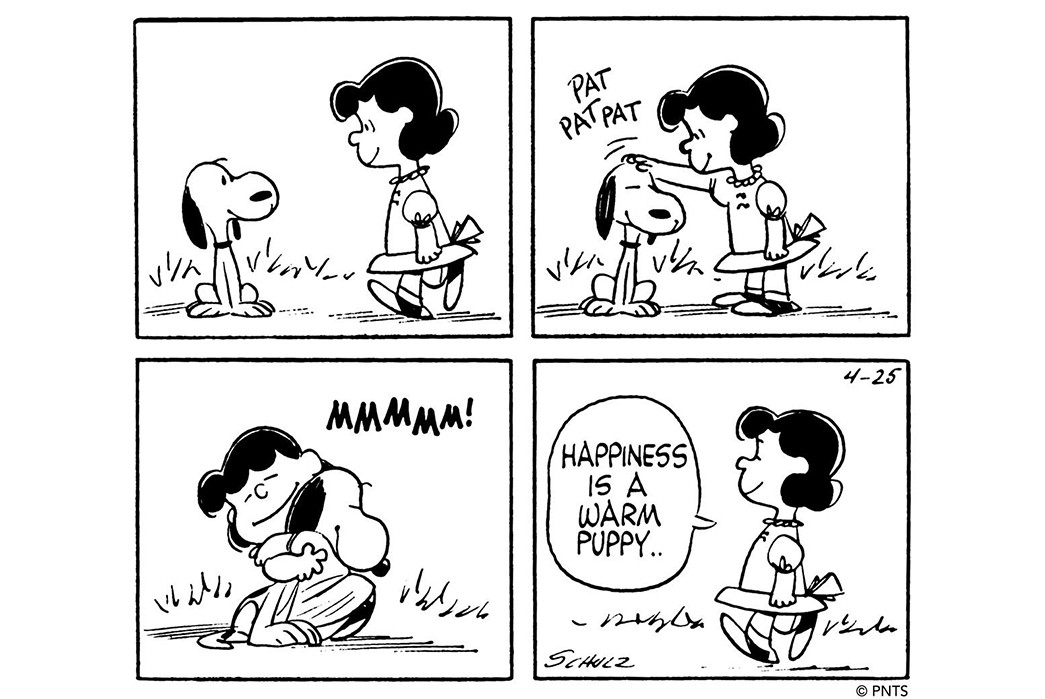
Strip via Peanuts/ PNTS
By the time Schulz died at 77 on February 12, 2000, he had personally written 17,897 Peanuts strips. It had been published in 2,600 newspapers in 21 languages in 75 countries across the world and was read by 355 million people. This makes it the most-read cartoon of all time—and the longest story ever told by one person. There are several reasons why Charlie Brown, Snoopy, and The Gang have seen such overwhelming global success.
Schulz created something that everyone can relate to. The main themes of the cartoon are surprising for something that is primarily aimed at children: loneliness, alienation, and how to be “good” in a cruel world—all of which were established in the very first four panels Schulz illustrated. Each member of The Gang is flawed in some way, Charlie Brown and his suffering, Lucy and her confused confidence, even Snoopy lives in a make-believe world, and they all struggle with relationships and the world around them. This was Schulz looking at himself and putting very adult thoughts into young characters. This, while being entertaining for the younger generations, was also poignant and empathetic for older people.
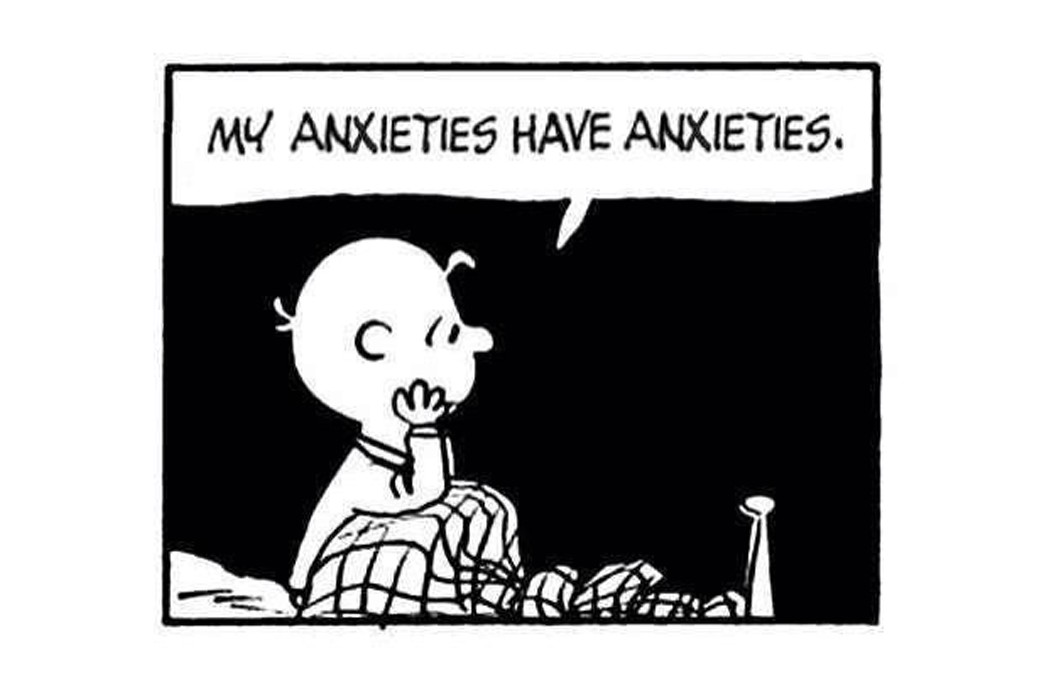
Charlie Brown, up at night, alone with these thoughts via The Coffeelicious
This is summed up particularly well in a poignant quote by Good Ol’ Charlie Brown himself:
“I have a new philosophy… I only dread one day at a time.”
This isn’t a new idea, though. In 1963, 13 years after the first Peanuts strip was published, Italian historian, philosopher, and semiotician, Umberto Eco, wrote an essay On ‘Krazy Kat’ and ‘Peanuts’ that suggested very similar notions that the reason for Peanuts’ success is that The Gang’s troubles echo what we fear as adults:
The poetry of these children arises from the fact that we find in them all the problems, all the sufferings of the adults, who remain offstage. These children affect us because in a certain sense they are monsters: they are the monstrous infantile reductions of all the neuroses of a modern citizen of industrial civilization.
Another reason for the immense success of Peanuts is that, throughout its 50-year run, it held a candle to American society. Peanuts started at the same time as another American literary revolution, the Beat Generation and the two expressed relatively similar ideas—though in very different manifestations. Like the Beats, Peanuts had counter-cultural influences weaved through its four-panel comics, from references to the Anti-War movement to Lucy’s relation to Second Wave Feminism. And this was directly published in national and international newspapers—Peanuts had a profound effect on culture across the world.
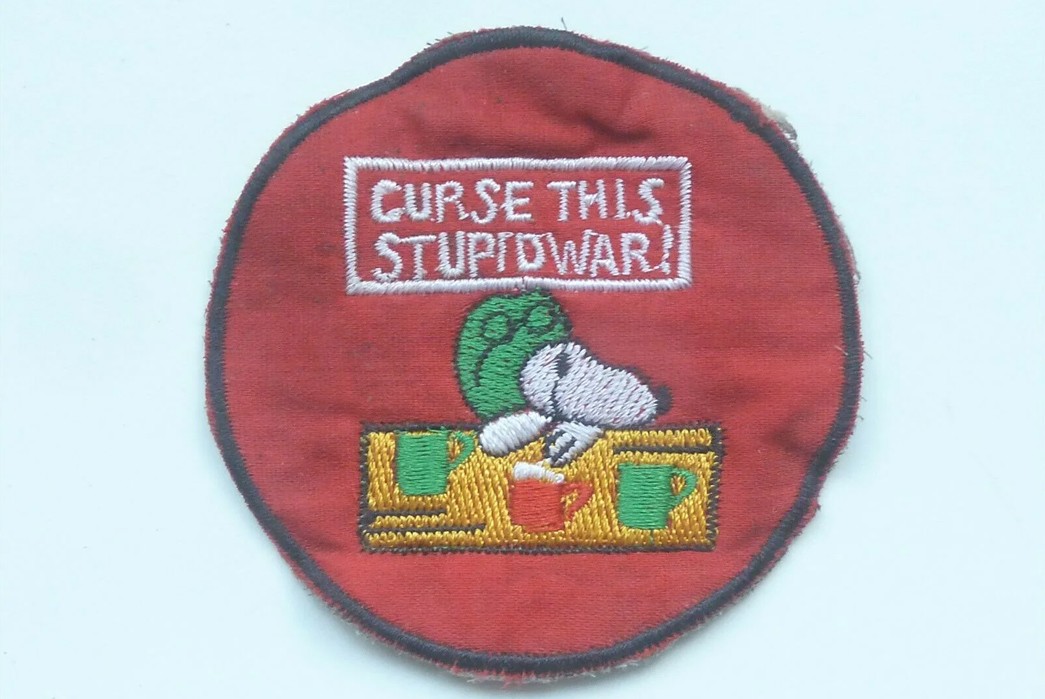
A Vietnam War-era Snoopy patch via Working Title Clothing
One final reason for Peanuts’ ongoing success 73 years after it was first published is that Schulz never shied away from licensing his characters, which we will explore in more depth in the second part of this series.

